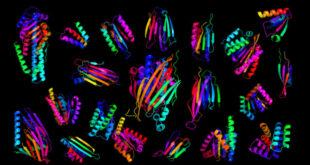Mitochondria are considered as the power-generating units of the cell due to their key role in energy metabolism and intercellular communication. However, cell-derived mitochondrial components could be found in the extracellular space, as fragments or encapsulated in vesicles. Now, a team of researchers has demonstrated that human blood contains whole functional mitochondria in normal physiological state.
Fluorescence microscopy image of cell-free mitochondria in the plasma of a healthy individual. Image credit: Dache et al, doi: 10.1096/fj.201901917RR.
“Previous studies showed that the plasma of a healthy individual contains up to 50,000 times more mitochondrial DNA than nuclear DNA,” said Dr. Alain Thierry, a researcher at the Montpellier Cancer Research Institute.
“We hypothesized that for it to be detectable and quantifiable in the blood in this manner, the mitochondrial DNA had to be protected by a structure of sufficient stability.”
“In order to identify such a structure, plasma samples from around 100 individuals were analyzed.”
The scientists found intact cell-free full-length mitochondrial DNA in dense and biologically stable structures in the samples.
These structures are over 0.22 µm in diameter and have specific mitochondrial proteins, double membranes and a morphology resembling that of mitochondria.
The study authors further demonstrate that these structurally intact cell-free mitochondria in the blood circulation are respiratory competent.
They estimated that there are between 200,000 and 3.7 million cell-free intact mitochondria per mL of plasma.
“When we consider the sheer number of extracellular mitochondria found in the blood, we have to ask why such a discovery had not been made before,” Dr. Thierry said.
“Our team has built up expertise in the specific and sensitive detection of DNA in the blood, by working on the fragmentation of extracellular DNA derived from the mitochondria in particular.”
“But what is the role of these extracellular mitochondria? The answer to that could be linked to the structure of the mitochondrial DNA, similar to that of bacterial DNA, which gives it the ability to induce immune and inflammatory responses.”
The researchers hypothesize that these circulating mitochondria could be implicated in many physiological and/or pathological processes requiring communication between the cells, such as the mechanisms of inflammation.
“The extracellular mitochondria could perform various tasks as messenger for the entire body,” Dr. Thierry said.
“In addition to its importance to our knowledge of physiology, this discovery could lead to improvements in the diagnosis, monitoring and treatment of certain diseases.”
The findings appear in The FASEB Journal.
_____
Zahra Al Amir Dache et al. Blood contains circulating cell-free respiratory competent mitochondria. The FASEB Journal, published online January 19, 2020; doi: 10.1096/fj.201901917RR
 #Bizwhiznetwork.com Innovation ΛI |Technology News
#Bizwhiznetwork.com Innovation ΛI |Technology News




